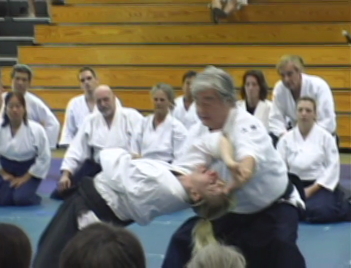 Yoshimitsu Yamada at Aikido Celebration Hawaii 2011
Yoshimitsu Yamada at Aikido Celebration Hawaii 2011
the 50th Anniversary of O-Sensei’s 1961 visit to Hawaii
Pat Hendricks taking ukemi
Yoshimitsu Yamada was sent to the United States in 1964 by the Aikikai in order to help spread and develop Aikido in America. He was followed by Mitsunari Kanai Sensei, Akira Tohei Sensei and Kazuo Chiba Sensei, whose cooperation eventually led to the formation of the United States Aikido Federation (USAF).
In the introduction to Part 1 of this interview below I spoke a little bit about my personal connection with Yamada Sensei, but there is one more personal connection that I have not yet mentioned.
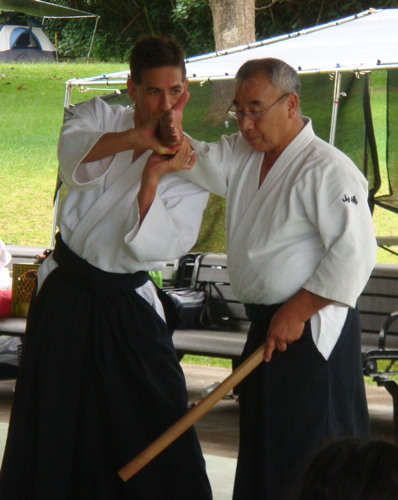 Taking ukemi for Takeshi Yamashima
Taking ukemi for Takeshi Yamashima
Ho’omaluhia Botanical Garden – 2011
Takeshi Yamashima was a long time student of Seigo Yamaguchi, and is famous for his soft, yet powerful, style of Aikido. He has been a regular at Hombu Dojo’s morning classes for many years and instructs at a number of dojo in the Tokyo area. He also holds a license in Yagyu Shinkage-ryu Kenjutsu.
I trained with him in Japan for three years, starting in 2000, and after returning to the United States I invited him to come to Hawaii. He has been visiting us in the Hawaiian Islands every year since 2004.
Takeshi Yamashima’s first Aikido teacher was….Yoshimitsu Yamada. As a young Hombu Dojo uchi-deshi Yamada Sensei was dispatched to oversee the instruction at the university dojo where Yamashima Sensei started Aikido!
This is the second of two parts of an interview that originally appeared in the April 2009 issue of Gekkan Hiden (月刊秘伝 / “Secret Teachings Monthly”), a well known martial arts magazine in Japan. You may with to read Part 1 of the interview before reading this section
This interview was also published in a collection of interviews with students of the Founder published in Japanese as 開祖の横顔 (“Profiles of the Founder”) in 2009. There was a short introduction to this work in the article “Morihei Ueshiba – Profiles of the Founder“. A number of English translations of interviews from that collection appeared have appeared previously – Nobuyoshi Tamura Sensei (Part 1 | Part 2), Hiroshi Isoyama Sensei (Part 1 | Part 2), Shigenobu Okumura Sensei (Part 1 | Part 2), Nobuyuki Watanabe Sensei (Part 1 | Part 2), and Masatake Fujita Sensei (Part 1 | Part 2).
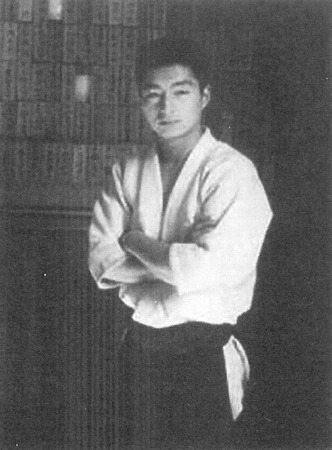 Yoshimitsu Yamada at Aikikai Hombu Dojo
Yoshimitsu Yamada at Aikikai Hombu Dojo
around twenty years old at the time
Interview with Aikido Shihan Yoshimitsu Yamada, Part 2
(translated by Christopher Li)
Q: It seems as if you were able to do Aikido from the very beginning.
A: Well, I certainly don’t remember having a very difficult time. I was good at sports when I was a student as well, but the first night I couldn’t sleep because my wrists hurt so much.
Q: So, the locks were applied strongly?
A: Nowadays the mainstream is to throw people showily, but at that time it was mostly locking and throwing or pinning techniques – holding them down and pinning them firmly. There wasn’t anybody gently teaching you shikko (膝行) exercises back then. At that time ukemi wasn’t taught, so you would suddenly find yourself thrown onto the wooden floor and somehow you would figure out yourself how to take ukemi roundly.
Q: That wasn’t Judo style, was it?
A: It was a wooden floor, so if you slapped you would go numb. For that reason we would roll roundly without making a sound. I think that teaching ukemi only began after we started training on tatami.
Q: It seems that it was a time when, rather than learning, it was more that one became accustomed to the training.
A: We just thought “This is the way it is”. For that reason one became used to figuring things out on their own. Even if it’s the same technique, if you do it the same way when the partner is different then it won’t work. In Aikido technique the truth is that one must work with a variety of partners and develop a body that is able to respond and adapt to the requirements of the moment, an approach based on logic doesn’t work.
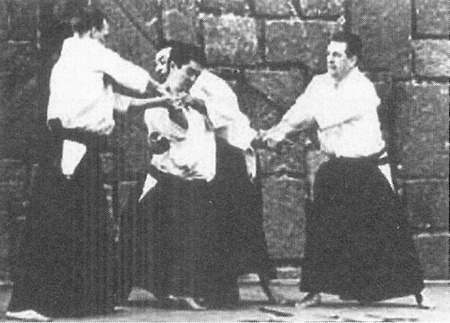 Yoshimitsu Yamada at one of his early New York demonstrations
Yoshimitsu Yamada at one of his early New York demonstrations
I find that New York particularly suits me
Q: After that you left for New York?
A: It was when I was twenty-six years old, after being an uchi-deshi for eight years. From the start I was able to speak English. I went to a mission school that had classes in English, and since I enjoyed Jazz and foreign music I was able to learn English through music and play with American children in the Shonan area. In junior and senior high school the only class where I scored more than 90% was English.
Q: So that was your foundation.
A: Yes. Even when I was an uchi-deshi I was sent out to Zama and Washington Heights for special training sessions with foreigners. Well…the truth is I still hadn’t trained enough yet… (laughing)
Q: What was it like when you actually went to America?
A: What I remember most is the dawn over New York when I arrived by Greyhound. I wasn’t emotional, I felt “I’ve come where I was meant to come”. It didn’t feel at all like I’d come from somewhere far away.
Q: Why was that?
A: I think that New York matched my personality. Put the other way, if it weren’t New York than I think that things wouldn’t have worked out. It had some kind of an attraction for my spirit.
Q: But, why New York?
A: At that time there wasn’t anybody who was teaching Aikido on the East Coast yet, and I was approached by people in the area who were practicing Judo.
*Translator’s Note: Aikido was actually well established in New York, and the New York Aikikai was in operation before Yoshimitsu Yamada ever arrived. There was a group of people under Yasuo Ohara including Eddie Hagihara, Virginia Mayhew (married to Eddie Hagihara at the time), Barry Bernstein, Fred Krase, and Ralph Glanstein (who later moved to Hawaii to train and teach Aikido). Meyer Goo, from the Big Island of Hawaii, also taught the group in New York for a time while he was going to school there.
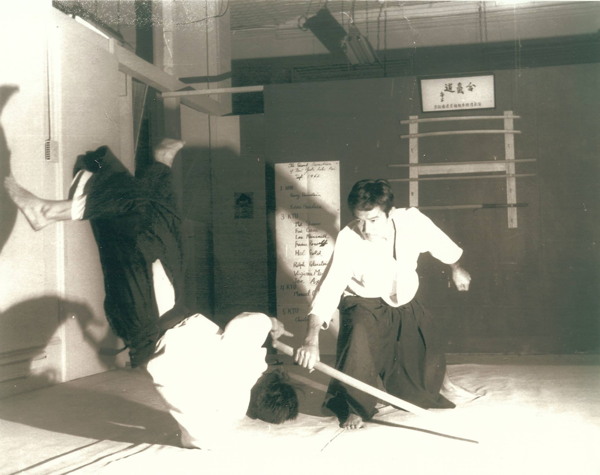 Hawaii Big Island boy Meyer Goo throwing Eddie Hagihara at the New York Aikikai
Hawaii Big Island boy Meyer Goo throwing Eddie Hagihara at the New York Aikikai
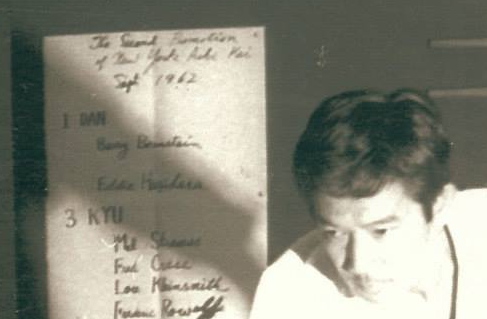 The promotion list on the wall reading:
The promotion list on the wall reading:
“The second promotion of New York Aiki Kai Sept 1962”
Barry Bernstein and Eddie Hagihara are listed as Sho-dan
Q: So did you teach at a Judo dojo at first?
A: No, I didn’t. Some people said “Would you like to join the New York Judo Federation?”, but I refused. I wanted freedom, even if I was going to be poor. I can say with confidence that this was the correct choice.
Q: Wasn’t it difficult at first?
A: Of course, nobody came. (laughing) My first dojo was about twenty tatami mats in size, and it didn’t even have a telephone. I didn’t have any money, so the dojo also served as my apartment. In the end it was only after two years had passed that I was able to rent a separate apartment and bring my wife and children from Japan.
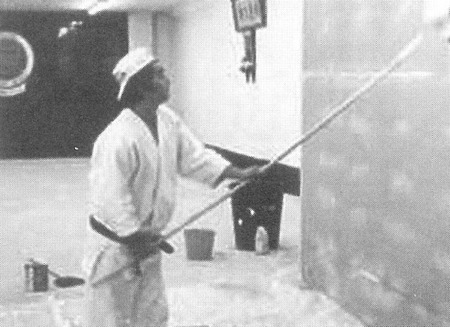 Yoshimitsu Yamada paints the New York Aikikai dojo
Yoshimitsu Yamada paints the New York Aikikai dojo
Q: You mean that you were already married at the time?
A: I left them with my parents. I was really reckless. (laughing)
Secret Stories – Repelling Dojo Storming
Q: Did you have any problems in New York?
A: I couldn’t attract many people at first. It was the time of the Karate boom. There were Karate tournaments here and there and they let me put on demonstrations, that was really good publicity. The leftovers from Karate came over to my side. (laughing) So at the time I would put on demonstrations at least twice a week, and now I hate seeing even the first letter of the word demonstration. (laughing) Also, that was the height of the hippy movement, and a lot of lazy folks who had heard “In Aikido you don’t have to do anything, you topple them with Ki” showed up. They wouldn’t practice at all, it was really difficult. (laughing)
Q: (laughing) That was exactly during the hippy period, wasn’t it?
A: When you watched them do Kokyu-dosa they would have their partner grasp their forearms and then they would just sit there. When I said “What are you doing?” they would say “Don’t bother me, I’m extending Ki”. I just gave up. (laughing) But I never once really thought “This is too tough, I want to quit”.
Q: So it really matched your personality.
A: When Koichi Tohei, who later left the Aikikai, came for three months I really gave up! He taught a lot of classes for me, and enrollment increased, but we lived in hotels and went drinking in expensive places every night. I just couldn’t keep up at all. Even now I don’t remember how we raised the money for it all. That was really tough. (laughing)
Q: (laughing) Was there any “Dojo Storming”?
A: None, none. There was just one time when a guy doing Judo came and said “I just can’t understand Aikido. Fight me now!”.
Q: What happened?
A: I closed the dojo so that the two of us were alone, and when I said “I’ll let you apply your favorite technique, what is it?”, he answered “Seo-nage” (背負投げ). “Perfect!”, I said. (laughing) When he actually came to throw me over his back I reversed him with Irimi and threw him easily. That’s quick thinking! (laughing)
Q: That’s wonderful!
A: But the next time that I gave an Aikido demonstration, when I stood up on the stage I saw that guy sitting in the front row. He had his students with him too, all in a row, and I thought “Is he going to come at me again?”. But just before the demonstration was to begin the guy stood up, turned to the audience, and said “He is so real!”. I automatically shook hands with him without even thinking about it. (laughing) So I guess that the way that you respond to people is important.
The Techniques of the Founder were Divine Works
A: I’ve always regretted that when the Founder passed away in 1969 (Showa year 44) I was not able to return home due to visa issues.
Q: You couldn’t return to the country temporarily?
A: At that time the visa situation was complicated, and if I went home I would not have been able to re-enter the United States, so in the end I wasn’t able to go home. I just had to endure it. Until that time I had the feeling, somewhere in my heart, that “Whenever I go back to Japan I will be able to be taught by the Founder”, even though I understood that this was unreasonable when I really considered his age.
Q: You thought that he would always be there?
A: Yes, that’s right. That’s why it was a shock when the time came and he passed away.
Q: Could I ask you again about your impressions of the Founder’s Aikido?
A: I think that the O-Sensei of the time in which I was learning was heavily colored by Aiki-jujutsu. The focus was on vertical movements, there were no round evasive movements, and locks were applied strongly. Irimi was also different from the soft movements of his later years. Before starting one would position themselves exactly and then enter sharply. So I think that it was very different from Kisshomaru Doshu’s era.
Q: How about your own Aikido?
A: Well, of course my Aikido now is different then how I would force things when I was younger. But I don’t want to hold onto Aikido until I start fooling myself, so I can’t change Aikido just to suit myself. Wouldn’t that be unfair? To make young people imitate an older person for that older person’s own convenience?
Q: So there is a young person’s training for young people?
A: Like the saying “strike while the iron’s hot”, it’s important to practice in a way that’s appropriate for your age while you are young. Anyway, once you get old you won’t be able to do anything but old person’s practice anyway.
Q: The Founder also did very severe training when he was young, didn’t he?
A: That’s right. It’s a lie that Aikido doesn’t need strength. That’s really just a way of saying that excess power is not needed. The amount of training that you do when you are young, those savings will return to you when you become older.
Q: I really feel the truth of those words in this series of articles.
A: When we did Koshi-nage there were those who said “O-Sensei never did that”, but those are mostly lazy instructors. It’s a shame that there are so many openings for such lazy people to enter such a marvelous and wonderful Budo. To the end, Aikido is about flesh against flesh. It’s impossible to throw somebody without touching them.
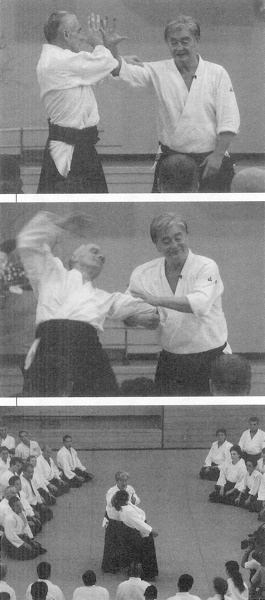 Yoshimitsu Yamada
Yoshimitsu Yamada
10th International Aikido Federation congress, 2008
Tanabe City, Japan
Q: What do you think is important when learning Aikido?
A: Don’t lower your own level. For that reason, steal the best parts of your Sempai, your Kohai and your Dohai. Steal, but don’t imitate. Digest them as best you can without hesitation. Anyway, it’s actually impossible to imitate other people, because the are different people. I think that’s why O-Sensei thought “It’s no good if I teach you”, even while he was teaching. In the end, if the person is different than the quality of their Aikido will be different. That is the beauty of Aikido, and its lot. In that sense, there is nobody who is doing O-Sensei’s Aikido. Real Aikido was just O-Sensei. The rest is just make-believe. (laughing)
Q: When we think about it this way, do you think that it was a good thing that Aikido changed in Kisshomaru Doshu’s era?
A: Yes, I think so. Doshu’s Aikido was very pure. That’s why I believe that it is a good starting point for aiming to reach the peak of that giant mountain called Aikido. After that you just have to find the way on your own. For that reason, you must train in way that is not collusive.
Q: Yes.
A: Once again, O-Sensei’s techniques were Divine Works (神業). The techniques were part of it, but also that he gave such a wonderful thing to so many people’s lives. I am truly grateful for this.
Q: Thank you for taking the time today to speak of such important things with us.
Gekkan Hiden Magazine, April 2009
Published by: Christopher Li – Honolulu, HI
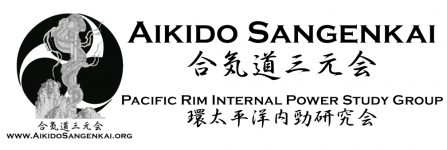
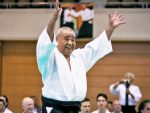
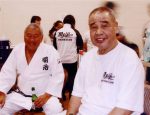
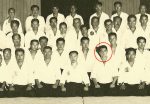
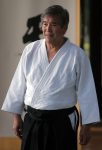
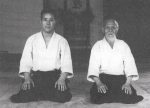

On your editor’s note, I find it hard to believe that Yamada Sensei was trying to mislead when he failed to mention the already active Aikido group in NY in the early 1960’s in this interview. In many other interviews he has explained that he came to NY for the 1964 World’s Fair and stayed because the already active group invited him to. When I was in NY Aikikai in the mid 1990’s, Eddie Hagihara was still teaching there once a month and the student body in general knew the story that Hagihara Sensei was active before Yamada Sensei came. My guess is that Sensei meant that in comparison to the West Coast, there wasn’t much less activity on the East Coast in general giving room for him to develop a student base with less competition.
You may well be correct…or you may not. Suffice it to say that some of the people I’ve spoken to who were there at the time have different perceptions of events.
Best,
Chris
“Aikido was actually well established in New York, and the New York Aikikai was in operation before Yoshimitsu Yamada ever arrived. There was a group of people under Yasuo Ohara including Eddie Hagihara, Virginia Mayhew (married to Eddie Hagihara at the time), Barry Bernstein, Fred Krase, and Ralph Glanstein (who later moved to Hawaii to train and teach Aikido). Meyer Goo, from the Big Island of Hawaii, also taught the group in New York for a time while he was going to school there.”
Edwin and I were Uchideshi for Yamada Sensei in the 90’s. Edwin reports accurately that Yamada Sensei speaks openly that New York Aikikai was in existence before he arrived. This is no secret but the official history of New York Aikikai. Most everyone at New York Aikikai knows this history as Sensei speaks on Virginia Mayhew, Bernie Brilstein and Eddie Hagihara starting the school.
In an otherwise fine interview this matter is an inaccuracy perhaps due to an oversight somehow in the interview. Yamada Sensei is still alive and vital. Please consider correcting this distortion of fact.
Edwin and I are well aware more than most that Yamada Sensei is an imperfect man in a number of ways but in the many years of dealing with him I have never known the man to lie on any matter. Particularly on a well known fact.
Please consider some revision or just calling Yamada Sensei so this can be corrected.
Hi Brian,
I myself knew Yamada Sensei back in the 1980’s. I can’t really comment on anything that he may have said at other times, but in the context of this interview there is really nothing that I can correct, it’s simply a translation of his own statement.
Best,
Chris
The picture with the caption “Yoshimitsu Yamada at one of his early New York demonstrations” was taken at the 1964 World’s Fair. See http://youtu.be/9RggCZNwF5o and http://youtu.be/QR2g9EbhNkY for film from that event with Yamada Sensei, Oscar Ratti, and other active Aikido students in NY from that era.
Chris, Thank you again for your on-going efforts to educate folks about our wonderful art. I also appreciate your connection with Yamashima Sensei. As an ‘Aiki searcher’, I regularly scour the web for martial artists and techniques/styles that intrique me. Yamashima Sensei stood out as a Aikido teacher that I would enjoy learning from.
Assuming that the translation was correct, I think that the statement from Mr. Yamada, “There wasn’t anybody teaching Aikido on the East Coast.” was extremely rude and borderline racist. As you mentioned there was a number of quality Aikidoka already learning the art. One person that also is deserving of mention is Frederick (Rick) Rowell Sensei. He is listed at the bottom of the page under 3rd Kyu in the above picture. He also is the far left uke in the picture where Mr. Yamada is contorted in his effort to throw three attackers. Rowell Sensei (5th Dan) is dojo cho of the Aikido of Diablo Valley in Concord Ca. He is leader of our small study group pursuing IP with Dan Harden. Unlike other senseis who are stuck in a box he has offered seminars with the following senseis of note; William Gleason (appearing again this month), Dan Harden, Soke Don Angier (Headmaster of the Yoshida Clan), Hiroshi Ikeda, Ellis Amdur, George Ledyard, Dennis Hooker, Chuck Clark, the Headmaster of Zen BudoKai (sorry, I forgot his name), and later this year, Howard Popkin (one of Seigo Okamoto’s top students). IMHO this is the attitude and exploration needed to reach ‘Divine Technique’
Sounds like an exciting place to train – Bill will be back out our way at the end of May, give him my regards!
Best,
Chris
The Wikipedia article on Yasuo Ohara has a reference link to a Black Belt Magazine (May 1965 issue) article about New York Aikikai. It mentions that Ohara-sensei started teaching, as 2nd Dan, in 1961, after he performed a demonstration, as a University Student, himself, at New York University. I would venture Aikikai thought of his teaching, as “unofficial” and as not more than “study group” status.
The article also states that Ohara-sensei was recalled to Japan, after which, Virginia Mayhew (a shodan, at the time) was leading the group for two years before Yamada-sensei’s (then 4th dan) arrival in 1964. It also mentions that Meyhew was only recently sent to Tokyo for 5 years [scheduled] of intensive study, which would support a strong vote of confidence in Mayhew’s potential.
Taking into consideration the time gap between Ohara-sensei’s departure and Yamada-sensei’s arrival, I don’t think Yamada’s statement can be considered a critique of Ohara. So, while Yamada’s statement about “nobody teaching on the East Coast” might sound harsh (at first glance), it is probably true from both his and Aikikai’s point of view.
Link to the Black Belt Magazine article: https://books.google.com/books?id=z9kDAAAAMBAJ&pg=PA47#v=onepage&q&f=false
Hi James,
I know a few of the guys who were there at the time pre-Yamada – Meyer Goo, who’s picture appears in the article and still lives on the Big Island, and the late Ralph Glanstein (his son still trains in Honolulu), and they saw things a little bit differently (as you can see from the article, for example, they were already promoting yudansha in 1962, showing that they were well established). Virginia Mayhew was the director of New York Aikikai in 1963-64 (with a dan rank directly from Morihei Ueshiba), until Yoshimitsu Yamada arrived (http://feministaikidoka.blogspot.com/2013/06/beginnings.html).
Best,
Chris